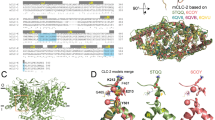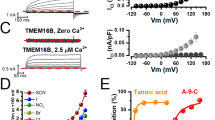Abstract
Ion channels allow ions to pass through cell membranes by forming aqueous permeation pathways (pores). In contrast to most known ion channels, which have single pores, a chloride channel belonging to the ClC family1 (Torpedo ClC-0) has functional features that suggest that it has a unique ‘double-barrelled’ architecture in which each of two subunits forms an independent pore. This model is based on single-channel recordings of ClC-0 that has two equally spaced and independently gated conductance states2,3,4. Other ClC isoforms do not behave in this way5,6, raising doubts about the applicability of the model to all ClC channels. Here we determine the pore stoichiometry of another ClC isoform, human ClC-1, by chemically modifying cysteines that have been substituted for other amino acids located within the ClC ion-selectivity filter7. The ClC-1 channel can be rendered completely susceptible to block by methanethiosulphonate reagents when only one of the two subunits contains substituted cysteines. Thiol side chains placed at corresponding positions in both subunits can form intersubunit disulphide bridges and coordinate Cd2+, indicating that the pore-forming regions from each subunit line the same conduction pathway. We conclude that human ClC-1 has a single functional pore.
This is a preview of subscription content, access via your institution
Access options
Subscribe to this journal
Receive 51 print issues and online access
$199.00 per year
only $3.90 per issue
Buy this article
- Purchase on Springer Link
- Instant access to full article PDF
Prices may be subject to local taxes which are calculated during checkout




Similar content being viewed by others
References
Jentsch, T. J. Molecular biology of voltage-gated chloride channels. Curr. Top. Membr. 42, 35–57 (1994).
Miller, C. Open-state substructure of single chloride channels from Torpedo electroplax. Phil. Trans. R. Soc. Lond. B 299, 401–411 (1982).
Middleton, R. E., Pheasant, D. J. & Miller, C. Homodimeric architecture of a ClC-type chloride ion channel. Nature 383, 337–340 (1996).
Ludewig, U., Pusch, M. & Jentsch, T. J. Two physically distinct pores in the dimeric CIC-0 chloride channel. Nature 383, 340–343 (1996).
Malinowska, D. H., Kupert, E. Y., Bahinski, A., Sherry, A. M. & Cuppoletti, J. Cloning, functional expression, and characterization of a PKA-activated gastric Cl− channel. Am. J. Physiol. Cell Physiol. 268, C191–C200 (1995).
Duan, D., Winter, C., Cowley, S., Hume, J. R. & Horowitz, B. Molecular identification of a volume-regulated chloride channel. Nature 390, 417–421 (1997).
Fahlke, Ch., Yu, H. T., Beck, C. L., Rhodes, T. H. & George, A. L. J Pore-forming segments in voltage-gated chloride channels. Nature 390, 529–532 (1997).
Middleton, R. E., Pheasant, D. J. & Miller, C. Purification, reconstitution, and subunit composition of a voltage-gated chloride channel from Torpedo electroplax. Biochemistry 33, 13189–13198 (1994).
Fahlke, Ch., Knittle, T. J., Gurnett, C. A., Campbell, K. P. & George, A. L. J Subunit stoichiometry of human muscle chloride channels. J. Gen. Physiol. 109, 93–104 (1997).
Roberts, D. D., Lewis, S. D., Ballou, D. P., Olson, S. T. & Shafer, J. A. Reactivity of small thiolate anions and cysteine-25 in papain toward methyl methanethiosulfate. Biochemistry 25, 5595–5601 (1986).
Fersht, A. R. Enzyme Structure and Mechanism (W. H. Freeman, New York, (1985)).
Cheung, M. & Akabas, M. H. Locating the anion-selectivity filter of the cystic fibrosis transmembrane conductance regulator (CFTR) chloride channel. J. Gen. Physiol. 109, 289–299 (1997).
Careaga, C. L. & Falke, J. J. Thermal motions of surface alpha-helices in the D-galactose chemosensory receptor. Detection by disulfide trapping. J. Mol. Biol. 226, 1219–1235 (1992).
Benitah, J. et al. Molecular motions within the pore of voltage-dependent sodium channels. Biophys. J. 73, 603–613 (1997).
Glusker, J. P. Structural aspects of metal liganding to functional groups in proteins. Adv. Protein Chem. 42, 1–76 (1991).
Benitah, J., Tomaselli, G. F. & Marban, E. Adjacent pore-lining residues within sodium channels identified by paired cysteine mutagenesis. Proc. Natl Acad. Sci. USA 93, 7392–7396 (1996).
Rychkov, G. Y. et al. pH-dependent interactions of Cd2+ and a carboxylate blocker with the rat ClC-1 chloride channel and its R304E mutant in the Sf-9 insect cell line. J. Physiol. (Lond.) 501, 355–362 (1997).
Heginbotham, L. & MacKinnon, R. The aromatic binding site for tetraethylammonium ion on potassium channels. Neuron 8, 483–491 (1992).
Carter, P. J., Winter, G., Wilkinson, A. J. & Fersht, A. R. The use of double mutants to detect structural changes in the active site of the tyrosyl-tRNA synthetase (Bacillus stearothermophilius ). Cell 38, 835–840 (1984).
Hidalgo, P. & MacKinnon, R. Revealing the architecture of a K+ channel pore through mutant cycles with a peptide inhibitor. Science 268, 307–310 (1995).
Root, M. J. & MacKinnon, R. Two identical noninteracting sites in an ion channel revealed by proton transfer. Science 265, 1852–1856 (1994).
Li, M., Unwin, N., Stauffer, K. A., Jan, Y. N. & Jan, L. Y. Images of purified Shaker potassium channels. Curr. Biol. 4, 110–115 (1994).
Doyle, D. A. et al. The structure of the potassium channel: Molecular basis of K+ conduction and selectivity. Science 280, 69–77 (1998).
Fahlke, Ch., Beck, C. L. & George, A. L. J Amutation in autosomal dominant myotonia congenita affects pore properties of the muscle chloride channel. Proc. Natl Acad. Sci. USA 94, 2729–2734 (1997).
Acknowledgements
We thank L. DeFelice, P. Hidalgo, M. Holmgren, R. Horn, J. P. Johnson, N. Mitrovic and C. I. Petersen for discussions and review of the manuscript. This work was supported by the Deutsche Forschungsgemeinschaft (Ch.F.), the Muscular Dystrophy Association (Ch.F., A.L.G.) and the National Institutes of Health (A.L.G.).
Author information
Authors and Affiliations
Corresponding author
Rights and permissions
About this article
Cite this article
Fahlke, C., Rhodes, T., Desai, R. et al. Pore stoichiometry of a voltage-gated chloride channel. Nature 394, 687–690 (1998). https://doi.org/10.1038/29319
Received:
Accepted:
Issue Date:
DOI: https://doi.org/10.1038/29319
This article is cited by
-
Diversity of Cl− Channels
Cellular and Molecular Life Sciences (2006)
-
Chloride channels are different
Nature (2002)
-
Projection structure of a ClC-type chloride channel at 6.5 Å resolution
Nature (2001)
Comments
By submitting a comment you agree to abide by our Terms and Community Guidelines. If you find something abusive or that does not comply with our terms or guidelines please flag it as inappropriate.



